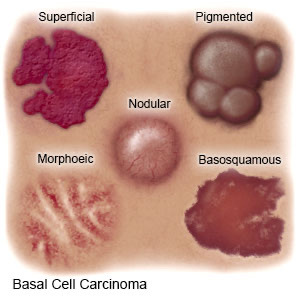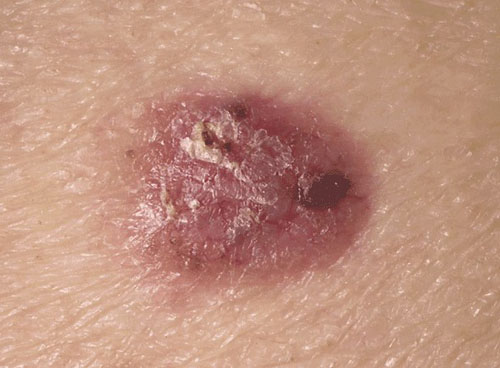
There are many types of basal cell cancer. Most of them develop on areas of the body that are frequently exposed to sunlight, such as the face, neck, scalp, and arms. In most cases, basal cell cancers begin as scaly or flat red patches. They may also appear as waxy white scars. Patients should never pick or scratch these lesions. Instead, they should see a dermatologist for a complete assessment.
Most basal cell carcinomas originate in the head and neck region. They may also affect the eyelids, zygomatic bone, ear, or forehead. Although they rarely spread to other parts of the body, they are often associated with a high mortality rate compared to other types of cancer. The characteristic of basal cell carcinomas is their cell-rich tumor stroma, making them particularly dangerous. These nodules can grow into ulcers or bleed easily, and if left untreated, they can result in considerable skin damage.
In most cases, basal cell carcinomas do not spread to other parts of the body. They may bleed after a minor injury or form a scab and heal on their own. Unlike other cancer types, basal cell carcinomas are rare and seldom cause death, though they can be extremely disfiguring. Despite its benign nature, they can lead to considerable cosmetic damage and functional difficulties. In extreme cases, it may spread to other parts of the body.
Most basal cell carcinomas begin as small, shiny bumps on the skin, and may appear anywhere on the body. They are most commonly found on the upper trunk, shoulders, and neck. They usually develop slowly and rarely show any symptoms until many years after the initial appearance. It is important to remember that basal cell cancers can recur in the same spot as the original tumor. Getting a timely diagnosis and treatment is essential for preventing recurrence.
The most common basal cell carcinomas occur on the face, neck, and eyes. It usually presents as an elevated, pearly white or gray-white bump with a translucent or waxy margin. Its color may vary from the color of the normal skin. It is generally white or pink. It may have several different types of appearances. Some cases present as nodules or ulcers. Moreover, the tumors may be infiltrative.

The most common basal cell cancer types are sclerosing and infiltrative. Infiltrative basal cell carcinomas can be located on the face. Symptoms of basal cell carcinoma include a pearly or translucent margin. The cancer may appear white, pink, or yellow. It is also possible for it to grow on the tongue, face, or arms. Those with dark skin are more likely to develop aggressive basal cell carcinomas.
Most patients with basal cell carcinoma have no symptoms and do not need treatment. In many cases, the disease grows slowly but does not spread. Infiltrative basal cell carcinoma may look like a waxy scar. As with any type of skin cancer, early detection is critical to prevent it from becoming a life-threatening condition. If you suspect that you have basal cell carcinoma, you should see a dermatologist immediately.
The site https://handaldok.com/ states that 80% of basal cell carcinomas occur in the head and neck region. The most common location is the inner corner of the eye. Its most common features include a pearlescent or translucent edge. In some cases, it may also have telangiectasia, which is the appearance of blood vessels on the surface. In any case, treatment for basal cell carcinoma depends on the stage of the cancer and how far it has spread.
Basal cell carcinoma is usually found in areas of the body that are most exposed to the sun. These cancers tend to grow slowly and are localized, but they can also spread to other parts of the body. Therefore, early detection is critical to prevent this disease. These types of skin cancer should be treated if they are found early. The best way to protect yourself from these skin cancers is to protect yourself from the sun.
There are many types of basal cell carcinoma. The most common type is nodular, which is characterized by white-gray tubercles. Micronodular basal cells are smaller and may resemble a pimple. If you notice any of these changes, you should seek immediate medical attention. Infiltrative basal cell carcinoma is a white collection of abnormal cells and is rare. Therefore, treatment for this type of cancer should only be undertaken if the affected area has a history of this type of cancer.